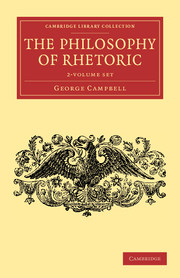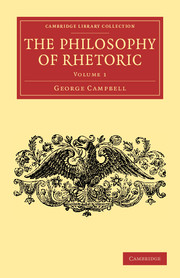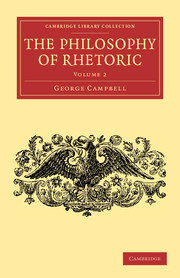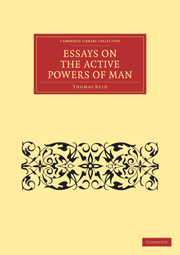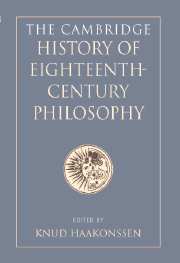The Philosophy of Rhetoric 2 Volume Set
A leading figure of the Scottish Enlightenment, George Campbell (1719–96) began what was to become his most famous work, The Philosophy of Rhetoric, soon after his ordination as a minister in 1748. Later, as a founder of the Aberdeen Philosophical Society, he was able to present his theories, and these discourses were published in 1776. In the spirit of the Enlightenment, Campbell combined classical rhetorical theory with the latest thinking in the social, behavioural and natural sciences. A proponent of 'common sense' philosophy, he was particularly interested in the effect of successful rhetoric upon the mind. Published in two volumes, the work is divided into three books. Book 1 emphasises the necessity of acknowledging and adapting to the needs of an audience. In Book 2, Campbell expands on the linguistic tools a successful rhetorician should employ. Book 3 discusses the correct selection, number and arrangement of words required for successful argument.
Product details
October 2013Multiple copy pack
9781108064385
992 pages
225 × 140 × 60 mm
1.1kg
Temporarily unavailable - available from July 2025
Table of Contents
- Volume 1: Preface
- Introduction
- Part I. The Nature and Foundations of Eloquence:
- 1. Eloquence in the largest acceptation defined
- 2. Of wit, humour, and ridicule
- 3. The doctrine of the preceding chapter defended
- 4. Of the relation which eloquence bears to logic and to grammar
- 5. Of the different sources of evidence, and the different subjects to which they are respectively adapted
- 6. Of the nature and use of the scholastic art of syllogising
- 7. Of the consideration which the speaker ought to have of the hearers as men in general
- 8. Of the consideration which the speaker ought to have of the hearers as men in particular
- 9. Of the consideration which the speaker ought to have of himself
- 10. The different kinds of public speaking in use among the moderns, compared, with a view to their different advantages in respect of eloquence
- 11. Of the cause of that pleasure which we receive from objects or representations that excite pity and other painful feelings
- Part II. The Foundations and Essential Properties of Elocution:
- 1. The nature and characters of the use which gives law to languages
- 2. The nature and use of verbal criticism, with its principal canons
- 3. Of grammatical purity
- 4. Some grammatical doubts in regard to English construction stated and examined. Volume 2:
- 5. Of the qualities of style strictly rhetorical
- 6. Of perspicuity
- 7. What is the cause that nonsense so often escapes being detected, both by the writer and by the reader
- 8. The extensive usefulness of perspicuity
- 9. May there not be an excess of perspicuity?
- Part III. The Discriminating Properties of Elocution:
- 1. Of vivacity as depending on the choice of words
- 2. Of vivacity as depending on the number of the words
- 3. Of vivacity as depending on the arrangement of the words
- 4. Of the connectives employed in combining the parts of a sentence
- 5. Of the connectives employed in combining the sentences in a discourse.

